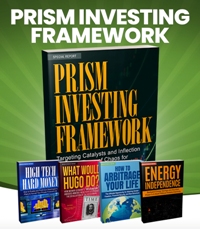 The major stock market indexes continue their push to new all-time highs. Year to date the S&P 500 is up 8.43 percent. The NASDAQ is up 9.22 percent over this time.
The major stock market indexes continue their push to new all-time highs. Year to date the S&P 500 is up 8.43 percent. The NASDAQ is up 9.22 percent over this time.
The tariff panic of early April has turned out to have been a delightful buying opportunity. Valuation metrics like the CAPE ratio and the Buffett Indicator are at the extreme of their extremes. No one seems to care.
Meme stocks are once again all the rage. On June 25, shares of Opendoor Technologies Inc. were trading for just $0.51. On July 21, they spiked to an interim high of $4.97 – an increase of 874 percent. Then they did an abrupt faceplant. At market close on July 24, these same shares were at $2.42.
Nothing has changed to Opendoor’s underlying online – iBuyer – real estate business over the last month that justifies the wild swings. But like GameStop and AMC Entertainment from several years ago, Opendoor has become a “meme stonk.” An object of speculative frenzy.
Meme stonks, if you’re unfamiliar with the phenomenon, are stocks that gain massive popularity, not because of a company’s financial strength, but because of viral hype on social media platforms like Reddit’s WallStreetBets.
These are crowd-sourced pumps, where individual retail investors rally around a certain stock. These meme stonks are often heavily shorted by big hedge funds. The goal is to create a short squeeze and force the big hedge funds to buy back shares at higher prices. This can drive the share price to the moon.
Meme stonks have nothing to do with traditional investing. They’re about collective action and an ‘us vs. them’ mentality.
Speculative Frenzy
Without questions, meme stonks are fascinating. And they’re largely part of a greater spectacle. They generally appear when the broad stock market has already become a speculative frenzy – like now.
As we’ve seen over the last several decades, these speculative frenzies often start with the hope of a new technological innovation. The early days of the internet, for example. Or the current promise of artificial intelligence.
The excitement stems from there being real potential for something transformative to occur. There’s also the anticipation this transformation will bring abundant wealth to early investors. Before long, the stocks of these related businesses are propelled upwards even if they don’t have the profits to support it.
Then fear of missing out (FOMO) kicks in. News outlets buzz, social media lights up, and everyone wants a piece of the action. Valuations blow out and companies with little to no profit see their stock prices soar. Traditional metrics are ignored.
Easy money, like low interest rates, can fuel this fire, making it cheaper to borrow and invest. Before you know it, what began as genuine enthusiasm transforms into a speculative bubble.
Taking an Austrian economics perspective offers a useful framework for understanding human action, individual choices, and how those choices ripple through the economy. Moreover, when it comes to recognizing and understanding bubbles, this perspective is essential.
Think about the dot-com bubble, the housing crisis of 2008, or even some of the recent meme stonk speculative frenzies we’ve seen. What causes these boom-and-bust cycles?
Many mainstream economic theories struggle to fully explain them without resorting to external shocks. But the Austrians offer a real, logical explanation.
Feel the Buzz
At its core, Austrian economics looks at the important role of time preference and capital structure. Time preference, in short, is how much we value something today versus something in the future. Would you rather spend a dollar today or save it for tomorrow?
When interest rates are set artificially low by central bank intervention, our time preference is altered. This is where the asset price bubble inflation happens. Low interest rates send distorted signals to entrepreneurs and investors. These low interest rates make projects that wouldn’t otherwise be profitable suddenly seem viable.
Money flows into these malinvestments, often in areas like real estate, technology, or commodities. These assets are inflated beyond their sustainable value. This is the boom.
The boom, no doubt, feels good while it is happening. There’s an exciting buzz in the air. Speculators who were early to the party get rich, while others buy in with the hopes of getting their hands on the easy wealth.
But, in reality, these investments aren’t built on a foundation of genuine savings or sustainable demand. They’re fueled by cheap credit.
Eventually, the misallocation of resources becomes evident. Interest rates may rise, or the artificial demand simply exhausts itself. Unsustainable projects fail and it becomes obvious that capital has been squandered.
Then the bubble bursts. Asset prices crash, and we’re left with the painful process of readjustment.
What gives Austrian economics an edge here is its focus on the importance of price signals as carriers of information and the effects that central planning, including fiscal and monetary policy, has in distorting those signals. The attempts of central planners to smooth out the business cycle through artificial means often sow the seeds for even bigger future dislocations.
Stargate’s AI Dreams Meet Reality
Today’s seeds of the current stock market bubble were sown in the coronavirus fiasco of 2020-22. Artificially low interest rates and massive deficit spending uncorked record consumer price inflation. When the Federal Reserve finally began raising interest rates in 2022 it was well behind the curve.
Stocks receded through the first nine months of 2022. But then with the release of ChatGPT and other AI chatbots a new bull market formed. Then, for political reasons, the Fed cut rates last September, November, and December.
Aside from the brief tariff panic in early April, stocks have bubbled up following these rate cuts. And now, with the expectation of further rate cuts, we’ve reached a speculative frenzy. Capital outlets, like NVIDIA and AMD are objects of speculation.
Since hitting interim lows in early April, NVIDIA and AMD are up 80 percent and 108 percent, respectively. Thanks to the AI boom, these companies have seen record demand for their chips. Their innovation and technological advancement are impressive.
But that doesn’t mean they are free from fundamental constraints. What happens if demand for AI chips slows even slightly?
For example, getting the data center infrastructure in place to support AI is proving easier said than done. Remember the hubbub about the Stargate project?
In January, there was an announcement at the White House with Japanese billionaire Masayoshi Son from SoftBank and Sam Altman from OpenAI and claims of a massive $500 billion investment. Stargate’s dream was to boost U.S. AI ambitions by building tons of data centers.
Here’s the reality of how things are going…
After six months, Stargate hasn’t completed a single deal for a data center. Now the company’s set a goal of building one small data center this year, probably in Ohio.
The AI boom and buildout is real. It’s bringing transformation. What’s more, we’re still early in the AI revolution.
But, once again, the stock market is getting well ahead of things. Enjoy the speculative frenzy while it lasts.
[Editor’s note: Have you ever heard of Henry Ford’s dream city of the South? Chances are you haven’t. That’s why I’ve recently published an important special report called, “Utility Payment Wealth – Profit from Henry Ford’s Dream City Business Model.” If discovering how this little-known aspect of American history can make you rich is of interest to you, then I encourage you to pick up a copy. It will cost you less than a penny.]
Sincerely,
MN Gordon
for Economic Prism
Return from Stargate’s Dreams Meet Reality to Economic Prism




